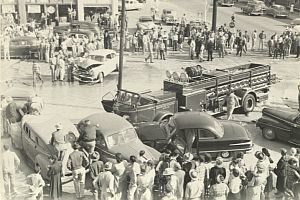Most Common Auto Injuries Explained
 Perhaps the most frequent injury involving automobiles comes from closing the door. Nearly 150,000 times a year, someone is injured in this fashion, and that’s with the car parked or stationary. This includes doors closing on fingers. Another 10,000 are injured by using a jack and 74,000 have been injured by a car or car part falling on them.
Perhaps the most frequent injury involving automobiles comes from closing the door. Nearly 150,000 times a year, someone is injured in this fashion, and that’s with the car parked or stationary. This includes doors closing on fingers. Another 10,000 are injured by using a jack and 74,000 have been injured by a car or car part falling on them.
But cars also move. Roughly one third of auto-related injuries occur due to an automobile striking someone, particularly pedestrians and bicyclists. Injuries can include anything from simple scrapes to multiple broken bones, dislocated vertebrae and damaged internal organs.
A Forbes magazine article noted that researchers from the US Department of Transportation “estimated an annual total of 1,747 fatalities and 841,000 injuries due to non-traffic crashes and non-crash incidents.” These included back-overs and single-car collisions not on a highway.
During a collision, passengers can be thrown about within the car, or be ejected from the vehicle (particularly if not wearing a seatbelt), causing significant injuries. One of the most serious of these is called traumatic brain injury (TBI). This is when the brain becomes bruised or otherwise injured. This can happen when the head is forced into rapid acceleration and/or deceleration from impact with other objects, such as a windshield, the body of the car or objects outside of the car. Such brain injuries can result in brain function impairment or even death.
Neck injuries include whiplash and vertebrae disk damage. These can result in a range of effects from persistent, long-term discomfort to debilitating pain and even immobility. Whiplash is perhaps the most common malady, which happens when the neck snaps quickly backward (during acceleration), then forward (during deceleration), causing hyperflexion and hyperextension of the cervical vertebrae. After an accident, the victim may be unaware of any damage, but may experience headaches or neck stiffness hours or days later.
A chiropractor can recognize this kind of damage using a variety of diagnostic tests with and can treat it with multiple adjustments, massage therapy and repetitive exercises performed by the patient at home. The chiropractor may even recommend a traction weight bag to help the neck return to its natural curve. Sometimes the damage is permanent, but treatment can reduce the discomfort and decrease in range of motion that might otherwise plague the patient.
Damage anywhere along the spine can occur during a car accident. This type of injury can range from mild to life-threatening. Dislocated vertebrae can result in excruciating pain that can lead to tight back muscles which intensify the problem. Physical therapy and chiropractic adjustments can help return the patient to health. Rehabilitative therapy can also include hot packs, massage, cold packs, traction, ultrasound, electrical stimulation and other methods.
When the spine is injured, symptoms can include difficulty breathing, tingling, numbness, paralysis, arm weakness, leg weakness, and unusual bladder or bowel control. If you are experiencing these or other unusual symptoms, seek proper care from a chiropractor or other health professional immediately.